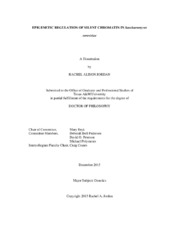| dc.description.abstract | The ribosomal DNA (rDNA) locus in Saccharomyces cerevisiae contains 150-200 tandem repeats of the ribosomal RNA genes. The rDNA acquires a special chromatin structure called silent chromatin that represses RNA Polymerase (Pol) II transcription and homologous recombination to protect the integrity of this ~1.8 Mb locus.
To better understand rDNA silent chromatin, sixteen yeast strains, each with a single Pol II-transcribed HIS3 reporter gene in a different rDNA repeat unit, were analyzed to compare silent chromatin in individual rDNA repeats across the rDNA array. Experiments comparing the level of HIS3 mRNA and the rate of recombination at the rDNA revealed that chromatin within individual rDNA repeats does not equally silence Pol II transcription and recombination. Repeat-specific variation in the strength of silent chromatin is called rDNA Position Effect. Chromatin immunoprecipitation experiments showed that the association of Sir2, a protein required for silent chromatin, varies at the HIS3 promoter; more Sir2 is associated with more silent rDNA repeats. The mechanism by which the association of Sir2 varies has not yet been identified. Until now, rDNA silent chromatin was assumed to be uniform across the rDNA array; the discovery of rDNA Position Effect alters this basic understanding and indicates rDNA silent chromatin is dynamic.
For further insight, a Tet-Off system is being developed to control the expression of Sir2. Depleting Sir2 by the addition of doxycycline to growth media compromises rDNA silent chromatin; removal of doxycycline allows for Sir2 to accumulate and rDNA silent chromatin to re-establish. Once optimized, this Tet-Off system will be used in experiments to investigate the establishment of rDNA silent chromatin in a single rDNA repeat unit by controlling the level of Sir2 in the cell.
Finally, spot plate growth analysis has revealed that cells lacking the histone methyltransferase Set1 are sensitive to the herbicide 3-Amino-1,2,4-triazole. Preliminary data suggest this new phenotype is due to the loss of methylation of lysine four of the histone H3 tail (H3K4). Assessment of mRNA levels supports a new role for H3K4 methylation in stress-response transcriptional regulation.
This research has increased the fundamental understanding of the conserved epigenetic regulation of chromatin. | en |


